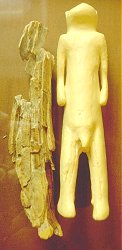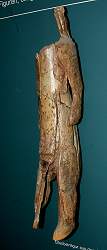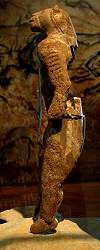Lionheaded Figurine

 Museum Ulm.
Museum Ulm.
 Urgeschichtliches Museum Blaubeuren.
Urgeschichtliches Museum Blaubeuren.
 Museum Ulm.
Museum Ulm.
 Museum Ulm.
Museum Ulm.
 Museum Ulm.
Museum Ulm.The Lionheaded Figurine is one of the oldest human sculptures of the World. It was found 1939 in the Stadel (7427/04) in the Hohlenstein near Asselfingen, Alb-Donau-Kreis, Germany. The original is now on display in the Museum Ulm (City Museum of Ulm), and is 31.1 cm high, 5.6 cm wide and 5,9 cm thick. It is carved out of mammoth ivory. The bent form of a mammoth tooth explains the characteristic general shape of the statute. The figurine shows a standing person, having both, human and animal features. The human body has the head of a cave lion (Panthera spelaea) and probably paws for hands. The arms simply hang downwards, but that’s the result of the original shape of the mammoth tooth.
The age was determined by
 C14-dating
of other finds in the same horizon to 35,000 to 41,000 years BP.
This time is called Aurignacién (43,000-26,000 BP), after the Abri von Aurignac (Haute-Garonne, France), where the first remains from this epoch were found.
It is also referred to as the Upper Paleolithic.
C14-dating
of other finds in the same horizon to 35,000 to 41,000 years BP.
This time is called Aurignacién (43,000-26,000 BP), after the Abri von Aurignac (Haute-Garonne, France), where the first remains from this epoch were found.
It is also referred to as the Upper Paleolithic.
In 1937, Prof. Robert Wetzel began systematic archaeological excavations in the Stadel, but they ended abruptly at the beginning of the Second World War. The figure was found in countless individual parts on 25-AUG-1939, on the last day of excavation by Otto Völzing in the presence of Robert Wetzel. Otto Völzing had his call-up order for the following day. The more than 200 tiny pieces of ivory were not recognizable as figurine, they were kept because some showed signs of having been worked on. Not all the fragments were found, although it can be assumed that those that were found together were all taken. The figure was probably exposed to destruction and transportation on the surface before it was covered by younger sediments and thus protected. The excavated material remained in the cave or was even returned to the trenches. The finds were stored provisionally and scientifically unprocessed in the storeroom of the Ulm Museum. Here it survived the Second World War undamaged, but was forgotten for decades. Prof. Wetzel resumed the excavations in the Stadel a few years after the war and continued them until 1961. However, he did not recognize the many ivory fragments as valuable and had long since forgotten them.
Prof. Dr. Joachim Hahn, a prehistorian from Tübingen, played a major role in the rediscovery of the lion man. In 1969, he sifted through the finds as part of inventory work and became aware of the fragments of the figure. He put the almost 200 fragments together to form a fully sculpted figure. This was the first time it became clear that the figure was an upright person with both human and animal features. The body bears the head of a cave lion. Hahn interpreted it as one of the few testimonies to the mythical-religious ideas of Palaeolithic man. This is no coincidence: although paintings of human figures with animal attributes are rare, they have been found several times in French and Spanish caves. They are interpreted as shamans in a ritual, either to improve luck in hunting or to invoke animal guardian spirits. Of course, the well-known American Indian legends about totem animals were also incorporated into these models, and Hahn had certainly read Karl May.
In 1982, the figure was completely reworked scientifically by Elisabeth Schmid. Further ivory fragments from the original excavation were integrated into the figure. Some had been found by hikers in the cave in 1974 and 1975. Others were found when Robert Wetzel’s study at the University of Tübingen was dismantled. The head and the left arm in particular were completed. As a result, the appearance changed considerably. Joachim Hahn had considered the figure to be male and described it as a lion man. Elisabeth Schmid came to the conclusion that it was the figure of a woman with the head of a cave lioness and referred to her as a lion woman. Overall, however, it is fair to say that there is insufficient evidence for either view, meaning that this is actually an ideologically tinged debate. We have therefore resorted to the gender-neutral name lion headed figurinee, as is generally done in literature.
As archaeologists in the 1930s did not record finds as meticulously as they do today, the exact location where the figurine was found, was unknown. In 2009, the Landesamt für Denkmalpflege (State Office for the Preservation of Monuments) carried out excavations in the Hohlenstein-Stadel under the direction of Claus-Joachim Kind. The location was rediscovered and further fragments were found. From 2011 to 2013, an archaeological excavation was carried out in the spoil heap from the first excavation in 1939. Numerous finds were made, including around 1,000 ivory fragments, many of which belong to this figurine. The figure was digitized using X-ray CT scan, as were the new fragments, and the digital model was virtually reassembled. In 2013, the figure was removed from the museum and the glue and beeswax fillings were removed. The figure was then reassembled using over 300 parts. The result has not just one arm, but two.
The first impression is that of a human figure. However, the lion’s head, the paw-like hands and the rather misshapen feet are actually those of a lion. The proportions of the body are distorted, which is of course primarily due to the shape of the tusk. And so there were also attempts to interpret the figure as a slightly unsuccessful depiction of a lion. However, this interpretation could not prevail. The figure is far too similar to the shamans known from the Magdalenian cave paintings in southern France. In these, the body often consists of various animals, only the dancing legs are human. The strange posture of the legs suggests ritual dances, but this is only a guess.
We have pictures of older restorations, arranged chronologically from top to bottom. This shows quite impressively the improvement of the reconstruction over decades of painstaking work. The best place to see the figure is, of course, the Ulm Museum, where the original is on display. Copies of the figure are exhibited in many museums around the world.
 Urgeschichtliches Museum Blaubeuren, Germany.
Urgeschichtliches Museum Blaubeuren, Germany. Museum Ulm, Germany.
Museum Ulm, Germany.- Museum Schloß Hohentübingen, Tübingen, Germany.
 Neanderthal Museum, Mettmann, Germany.
Neanderthal Museum, Mettmann, Germany.- Naturhistorisches Museum, Basel, Switzerland.
- Naturhistorisches Museum, Wien, Austria.
- American Museum of Natural History, New York, United States of America.
History
| 1937 | systematic excavations at Hohlenstein-Stadel cave by Prof. Robert Wetzel. |
| 25-AUG-1939 | discovered by the geologist Otto Völzing and Prof. Robert Wetzel on the last day of the excavation. |
| 1961 | excavations by Prof. Robert Wetzel end. |
| 1969 | Joachim Hahn came across the more than 200 pieces and assembled them into a 31-cm-tall figurine of a humanoid with a lion’s head. |
| 1988 | after the discovery of more fragments from the original excavation Elisabeth Schmid makes a completely new reconstruction. |
Literature
- Kurt Wehrberger Hrsg. (1994):
Der Löwenmensch, Tier und Mensch in der Kunst der Eiszeit
Ulmer Museum, Ausstellungskatalog, Thorbecke, Sigmaringen, 144 S., Abb., 33,- DM.
ISBN-10: 3928738046, ISBN-13: 978-3928738040.

- Dieter Kapff (2004):
Der Löwenmensch vom Lonetal im Computertomograf vermessen,
Schwäbische Heimat 55 (2004), 4, Seite 458-461.
ISSN 2750-4662.
online
pdf
DOI

- Kurt Wehrberger Hrsg. (2013):
Die Rückkehr des Löwenmenschen - Geschichte, Mythos, Magie,
Begleitbuch zur Ausstellung, Ulmer Museum, 15-NOV-2013 - 09-JUN-2014.
Ostfildern : Thorbecke, 2013.
online

- Claus-Joachim Kind Hrsg. (2019):
Löwenmensch und mehr - die Ausgrabungen 2008-2013 in den altsteinzeitlichen Schichten der Stadel-Höhle im Hohlenstein (Lonetal), Gemeinde Asselfingen, Alb-Donau-Kreis,
Forschungen und Berichte zur Archäologie in Baden-Württemberg Band 15, 206 Seiten ; Illustrationen, Diagramme, Pläne, Karten ; 29.7 cm x 21 cm, 1021 g.
Wiesbaden, Dr. Ludwig Reichert Verlag, 2019.
ISBN 9783969290675.
online
DOI

 Subterranean World Heritage List
Subterranean World Heritage List Lion man - Wikipedia
Lion man - Wikipedia Museum Ulm Archaeology (visited: 21-APR-2025)
Museum Ulm Archaeology (visited: 21-APR-2025) Index
Index Topics
Topics Hierarchical
Hierarchical Countries
Countries Maps
Maps Search
Search